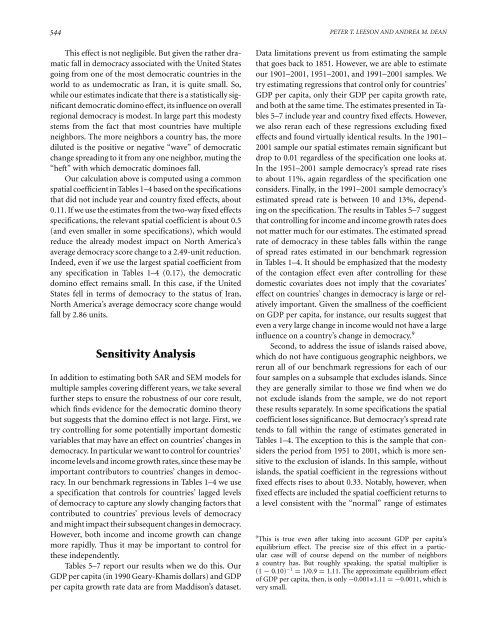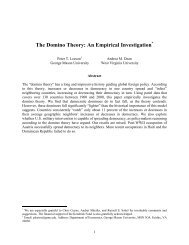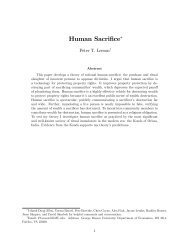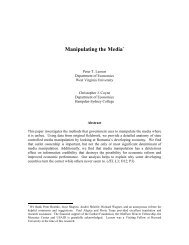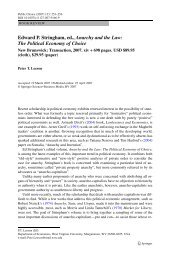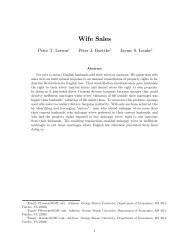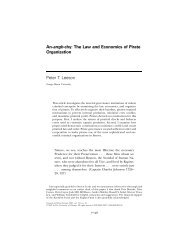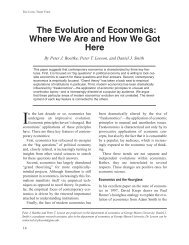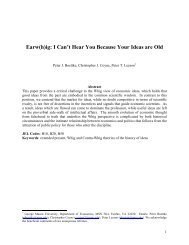The Democratic Domino Theory: An Empirical Investigation
The Democratic Domino Theory: An Empirical Investigation
The Democratic Domino Theory: An Empirical Investigation
You also want an ePaper? Increase the reach of your titles
YUMPU automatically turns print PDFs into web optimized ePapers that Google loves.
544 PETER T. LEESON AND ANDREA M. DEAN<br />
This effect is not negligible. But given the rather dramatic<br />
fall in democracy associated with the United States<br />
going from one of the most democratic countries in the<br />
world to as undemocratic as Iran, it is quite small. So,<br />
while our estimates indicate that there is a statistically significant<br />
democratic domino effect, its influence on overall<br />
regional democracy is modest. In large part this modesty<br />
stems from the fact that most countries have multiple<br />
neighbors. <strong>The</strong> more neighbors a country has, the more<br />
diluted is the positive or negative “wave” of democratic<br />
change spreading to it from any one neighbor, muting the<br />
“heft” with which democratic dominoes fall.<br />
Our calculation above is computed using a common<br />
spatial coefficient in Tables 1–4 based on the specifications<br />
that did not include year and country fixed effects, about<br />
0.11. If we use the estimates from the two-way fixed effects<br />
specifications, the relevant spatial coefficient is about 0.5<br />
(and even smaller in some specifications), which would<br />
reduce the already modest impact on North America’s<br />
average democracy score change to a 2.49-unit reduction.<br />
Indeed, even if we use the largest spatial coefficient from<br />
any specification in Tables 1–4 (0.17), the democratic<br />
domino effect remains small. In this case, if the United<br />
States fell in terms of democracy to the status of Iran,<br />
North America’s average democracy score change would<br />
fall by 2.86 units.<br />
Sensitivity <strong>An</strong>alysis<br />
In addition to estimating both SAR and SEM models for<br />
multiple samples covering different years, we take several<br />
further steps to ensure the robustness of our core result,<br />
which finds evidence for the democratic domino theory<br />
but suggests that the domino effect is not large. First, we<br />
try controlling for some potentially important domestic<br />
variables that may have an effect on countries’ changes in<br />
democracy. In particular we want to control for countries’<br />
income levels and income growth rates, since these may be<br />
important contributors to countries’ changes in democracy.<br />
In our benchmark regressions in Tables 1–4 we use<br />
a specification that controls for countries’ lagged levels<br />
of democracy to capture any slowly changing factors that<br />
contributed to countries’ previous levels of democracy<br />
and might impact their subsequent changes in democracy.<br />
However, both income and income growth can change<br />
more rapidly. Thus it may be important to control for<br />
these independently.<br />
Tables 5–7 report our results when we do this. Our<br />
GDP per capita (in 1990 Geary-Khamis dollars) and GDP<br />
per capita growth rate data are from Maddison’s dataset.<br />
Data limitations prevent us from estimating the sample<br />
that goes back to 1851. However, we are able to estimate<br />
our 1901–2001, 1951–2001, and 1991–2001 samples. We<br />
try estimating regressions that control only for countries’<br />
GDP per capita, only their GDP per capita growth rate,<br />
and both at the same time. <strong>The</strong> estimates presented in Tables<br />
5–7 include year and country fixed effects. However,<br />
we also reran each of these regressions excluding fixed<br />
effects and found virtually identical results. In the 1901–<br />
2001 sample our spatial estimates remain significant but<br />
drop to 0.01 regardless of the specification one looks at.<br />
In the 1951–2001 sample democracy’s spread rate rises<br />
to about 11%, again regardless of the specification one<br />
considers. Finally, in the 1991–2001 sample democracy’s<br />
estimated spread rate is between 10 and 13%, depending<br />
on the specification. <strong>The</strong> results in Tables 5–7 suggest<br />
that controlling for income and income growth rates does<br />
not matter much for our estimates. <strong>The</strong> estimated spread<br />
rate of democracy in these tables falls within the range<br />
of spread rates estimated in our benchmark regression<br />
in Tables 1–4. It should be emphasized that the modesty<br />
of the contagion effect even after controlling for these<br />
domestic covariates does not imply that the covariates’<br />
effect on countries’ changes in democracy is large or relatively<br />
important. Given the smallness of the coefficient<br />
on GDP per capita, for instance, our results suggest that<br />
even a very large change in income would not have a large<br />
influence on a country’s change in democracy. 9<br />
Second, to address the issue of islands raised above,<br />
which do not have contiguous geographic neighbors, we<br />
rerun all of our benchmark regressions for each of our<br />
four samples on a subsample that excludes islands. Since<br />
they are generally similar to those we find when we do<br />
not exclude islands from the sample, we do not report<br />
these results separately. In some specifications the spatial<br />
coefficient loses significance. But democracy’s spread rate<br />
tends to fall within the range of estimates generated in<br />
Tables 1–4. <strong>The</strong> exception to this is the sample that considers<br />
the period from 1951 to 2001, which is more sensitive<br />
to the exclusion of islands. In this sample, without<br />
islands, the spatial coefficient in the regressions without<br />
fixed effects rises to about 0.33. Notably, however, when<br />
fixed effects are included the spatial coefficient returns to<br />
a level consistent with the “normal” range of estimates<br />
9 This is true even after taking into account GDP per capita’s<br />
equilibrium effect. <strong>The</strong> precise size of this effect in a particular<br />
case will of course depend on the number of neighbors<br />
a country has. But roughly speaking, the spatial multiplier is<br />
(1 − 0.10) −1 = 1/0.9 = 1.11. <strong>The</strong> approximate equilibrium effect<br />
of GDP per capita, then, is only −0.001∗1.11 =−0.0011, which is<br />
very small.


